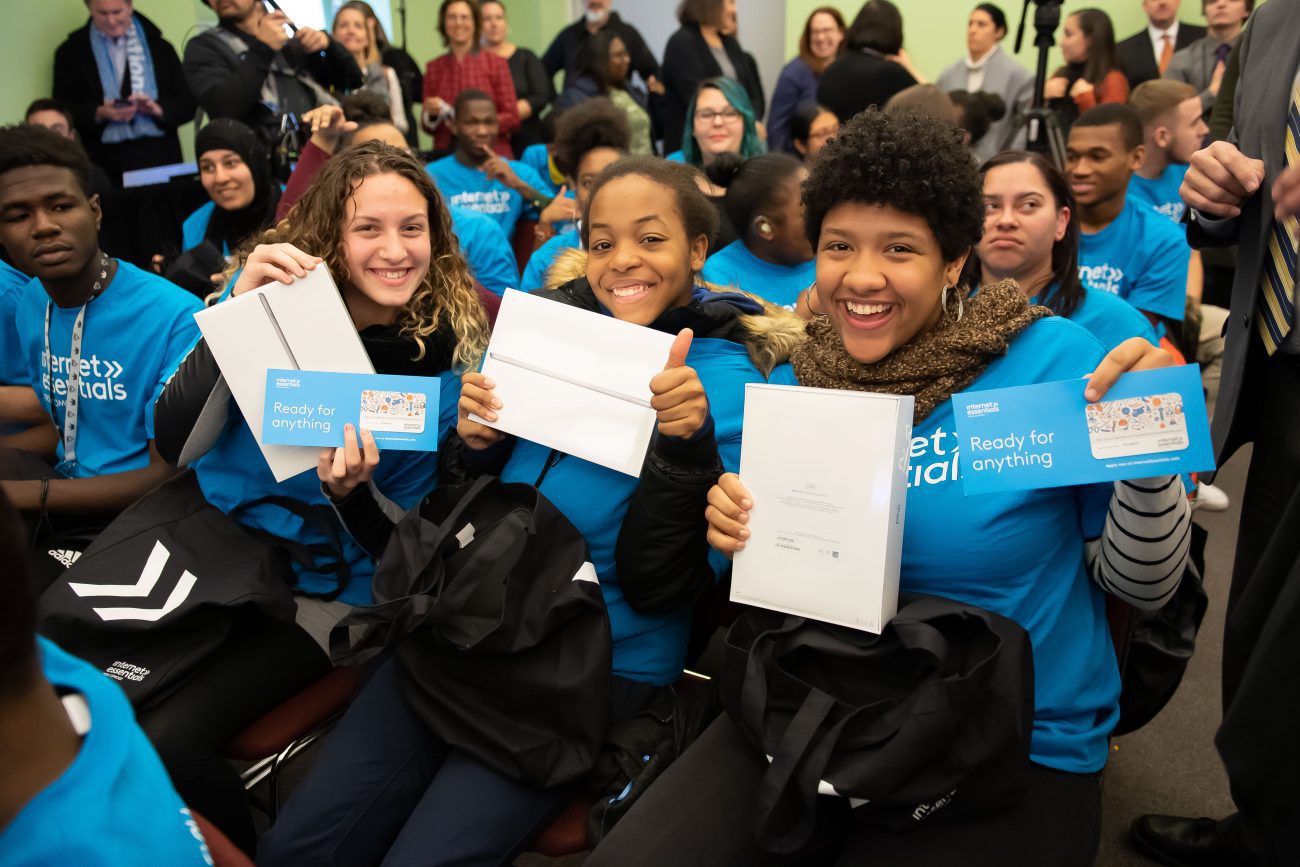Comcast Expands Accessibility and Outreach, Launches ASL Resources
With expansion of Internet Essentials, and new resources for those with disabilities, Comcast hopes to bridge the digital divide.

Pennsylvania School for the Deaf (PSD) student Jacob Cross looked at the blank space on his Comcast-issued “Ready for Anything” card (bearing the tagline of Comcast’s Internet Essentials program) – the cards seek to find out what students might be ready for, if only they had reliable access to the Internet at home. “I’m ready to search for a job on the internet,” he wrote. His classmate Natalia Gilmore wrote, “I’m ready to succeed.”
The students shared their answers on stage as they were the first of 90 PSD students to be surprised with free iPads and Opportunity Cards for six months of free Internet Essentials access from Comcast during a digital inclusion rally on December 3–a day which happened to be both Giving Tuesday and International Day of Disabled Persons. Comcast, in partnership with Dell Technologies, also donated new computer equipment to PSD for students to learn vital digital skills.
Fellow student Nadia Walker shared her answer as well: “I’m ready to take over the world.”
Since Internet Essentials’ 2011 launch, thousands of answers scrawled onto those cards have told the story— the transformative effect that access can have, and the debilitating effects that the digital divide can have as well.
“Internet is the great equalizer,” said David L. Cohen, Senior Executive Vice President and Chief Diversity Officer at Comcast. “You can’t even apply for a job in 80 percent of Fortune 500 companies without the Internet. It is a sobering thought that when we started, 30 percent of the country didn’t have Internet.”

Today, Comcast has connected more than eight million low-income Americans to the Internet through its Internet Essentials program, including nearly 290,000 people in Philadelphia (90 percent of whom were not connected to the Internet at home until they signed up through Internet Essentials). Structured as a partnership between Comcast and tens of thousands of school districts, governmental leaders, and nonprofit community partners; Internet Essentials has grown to become the largest and most comprehensive broadband adoption program for low-income families in the United States.
“It’s the comprehensive soup-to-nuts approach that has made Internet Essentials more successful than other programs,” remarked Cohen. The program is successful because it does not simply give people low-cost access to the internet, but addresses the three major barriers to broadband adoption: difficulty affording internet services, lack of a computer, and lack of digital literacy skills. Internet Essentials seeks to provide “wrap-around” support to correct each barrier. Thus, the program includes low-cost high-speed internet access (for $9.95 per month), the option to purchase a computer for under $150, and free digital literacy education.
But there is always more that can be done. This year, Internet Essentials had its largest expansion yet, to include all qualified low-income households, including people with disabilities. According to Pew Research Center, 23 percent of people with disabilities say they never go online, and 57 percent say they do not have a home broadband subscription. The digital divide in this community is even more pronounced and can lead to more isolation and frustration due to lack of accessibility.
Recognizing this challenge, Comcast announced a collaboration with Communication Service for the Deaf (CSD) to create customer service support via American Sign Language (ASL) for Internet Essentials, Xfinity Internet, and general Xfinity billing questions, called ASL Now. This is a first for the cable industry.
“Comcast’s commitment to launching an ASL customer service center underlines a shift in attitude by major corporations in recognizing the value of deaf people and the benefit and ease in delivering exceptional customer service through their customers’ language of choice,” said Christopher Soukup, Chief Executive Officer of CSD.
Comcast also created an internetessentials.com/accessibility landing page, with direct links to the new ASL Now chat function, the ability to order materials in Braille and large print, and accessibility-specific FAQ. They are also working on adding videos with closed captioning to their Internet Essentials digital literacy suite (there are currently almost 50 such videos), and to create even more training content to the Learning Portal that will be specifically designed for people with disabilities.

As Mayor Jim Kenney and leaders from Comcast handed out the surprise iPads to PSD students, the hope in the room was transcendent. The joy the students in the audience felt for their peers on stage when it seemed like just those three lucky kids were recipients was genuine and shared. And then when 87 more iPads came out, and the kids excitedly communicated to each other with rapid ASL, it was a celebration (waving pom poms included).
To Cohen, this was simply the way things ought to be. In an interview earlier that morning, he opened up about his upbringing, describing how his parents and grandparents raised him with a sense of social justice and the “moral obligation” to give back, equalize opportunity, and leave no one behind. “This should be a huge business community priority…They have the same dreams and aspirations as our kids do, and shame on us if we don’t make those dreams a reality.”
To learn more about Comcast Internet Essentials, and to help others in your community gain access to low-cost internet resources, visit internetessentials.com.
Photographs courtesy of Comcast. Comcast sponsored this post for the Philly Family Community.



NO COMMENTS